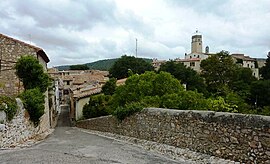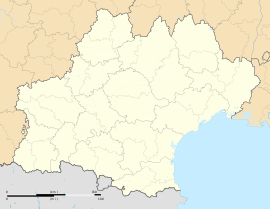Puéchabon (French pronunciation: [pɥeʃabɔ̃]; Occitan: Puèg-Abon, [pɥɛt͡ʃ.a'bu]) is a commune in the Hérault department in the Occitanie region in Southern France.
Puéchabon
Puèg-Abon (Occitan) | |
|---|---|
 A general view of Puéchabon | |
| Coordinates: 43°42′55″N 3°37′06″E / 43.7153°N 3.6183°E | |
| Country | France |
| Region | Occitania |
| Department | Hérault |
| Arrondissement | Lodève |
| Canton | Gignac |
| Intercommunality | Vallée de l'Hérault |
| Government | |
| • Mayor (2020–2026) | Xavier Peyraud[1] |
| Area 1 | 31.26 km2 (12.07 sq mi) |
| Population (2021)[2] | 504 |
| • Density | 16/km2 (42/sq mi) |
| Demonym | Puéchabonais |
| Time zone | UTC+01:00 (CET) |
| • Summer (DST) | UTC+02:00 (CEST) |
| INSEE/Postal code | 34221 /34150 |
| Elevation | 54–483 m (177–1,585 ft) (avg. 110 m or 360 ft) |
| Website | communedepuechabon.fr |
| 1 French Land Register data, which excludes lakes, ponds, glaciers > 1 km2 (0.386 sq mi or 247 acres) and river estuaries. | |
Geography
editThe commune borders Causse-de-la-Selle to the north, Saint-Guilhem-le-Désert to the north and west, Aniane to the south, and La Boissière to the southeast.
Climate
editIn 2010, the climate of the commune is classified as a frank Mediterranean climate, according to a study based on a dataset covering the 1971-2000 period.[3] In 2020, Météo-France published a typology of climates in mainland France in which the commune is exposed to a Mediterranean climate and is part of the Provence, Languedoc-Roussillon climatic region, characterized by low rainfall in summer, very good sunshine (2,600 h/year), a hot summer 21.5 °C (71 °F), very dry air in summer, dry conditions in all seasons, strong winds (with a frequency of 40 to 50% for winds > 5 m/s), and little fog.[4]
For the 1971-2000 period, the average annual temperature was 14 °C (57 °F) with an annual atmospheric temperature of 16 °C (61 °F). The average annual total rainfall during this period was 931 mm, with 6.9 days of precipitation in January and 3.1 days in July.[3] For the subsequent period of 1991 to 2020, the average annual temperature observed at the nearest weather station, located in the commune of Saint-André-de-Sangonis, 12 kilometres (7 mi) away as the crow flies,[5] is 15.5 °C (60 °F), and the average annual total rainfall is 652.4 mm.[6][7]
For the future, climate parameters for the commune projected for 2050, based on different greenhouse gas emission scenarios, can be consulted on a dedicated website published by Météo-France in November 2022.[8]
Urbanism
editTypology
editAs of January 1, 2024, Puéchabon is classified as an ‘commune rurale à habitat dispersé’ (rural commune with dispersed settlement) according to the new seven-level commune density grid established by Insee in 2022.[l 1] The commune is located outside of any urban unit.[l 2] Additionally, Puéchabon belongs to the Montpellier attraction area, where it is designated as a commuter town.[Note 1][l 2] This area, encompassing 161 communes, falls under the category of areas with 700,000 inhabitants or more (excluding Paris).[l 3]
Land Use
editThe land use in the commune, as recorded in the European biophysical land use database, Corine Land Cover (CLC), is characterized by a high proportion of forests and semi-natural habitats, accounting 90.8 % in 2018, an approximately equivalent proportion compared to that of 1990, 91.2%. The detailed distribution in 2018 was as follows: shrub and/or herbaceous vegetation environments (67.4%), forests (20.3%), permanent crops (7%), open spaces, with little or no vegetation (3.1%), urban areas (1.1%), heterogeneous agricultural areas (1.1%).[9] Changes in the commune’s land use and infrastructure can be observed on various cartographic representations of the area: the Cassini map (18th century), the military topographic map (1820–1866), and IGN maps or aerial photographs from 1950 to the present day.[Map 1]
Population
editChanges in the number of inhabitants have been documented through population censuses conducted in the commune since 1793. For communes with fewer than 10,000 inhabitants, a full census of the population is conducted every five years, with the legal populations for the intervening years estimated through interpolation or extrapolation.[10] For this commune, the first complete census under the new system was carried out in 2005.[11]
In 2021, the commune had a population of 504,[Note 2] reflecting an increase of +5.88 since 2015 (Hérault: +7.29%, France excluding Mayotte: +1.84%).
|
| |||||||||||||||||||||||||||||||||||||||||||||||||||||||||||||||||||||||||||||||||||||||||||||||||||||||||||||||||||||||||||
| Source: Ldh/EHESS/Cassini until 1999,[12] and INSEE since 2006.[13] | ||||||||||||||||||||||||||||||||||||||||||||||||||||||||||||||||||||||||||||||||||||||||||||||||||||||||||||||||||||||||||||
See also
editNotes and references
editNotes and maps
editNotes
edit- ^ The concept of an functional area replaced the former concept of an urban area in October 2020, enabling consistent comparisons with other European Union countries.
- ^ Legal municipal population effective as of January 1, 2024, based on 2021 data, defined within the territorial boundaries effective as of January 1, 2023, with a statistical reference date of January 1, 2021.
Maps
edit- ^ "Évolution comparée de l'occupation des sols de la commune sur cartes anciennes". remonterletemps.ign.fr (in French). Retrieved 3 November 2024.
References
editInsee website
edit- ^ "La grille communale de densité". insee.fr (in French). 28 May 2024. Retrieved 26 October 2024.
- ^ a b "Métadonnées de la commune de Puéchabon". Insee (in French).
- ^ "Liste des communes composant l'aire d'attraction de Montpellier". insee.fr (in French). Retrieved 26 October 2024.
Other Sources
edit- ^ "Répertoire national des élus: les maires". data.gouv.fr, Plateforme ouverte des données publiques françaises (in French). 9 August 2021.
- ^ "Populations légales 2021" (in French). The National Institute of Statistics and Economic Studies. 28 December 2023.
- ^ a b Joly, Daniel; Brossard, Thierry; Cardot, Hervé; Cavailhes, Jean; Hilal, Mohamed; Wavresky, Pierre (18 June 2010). "Climate Types in France: A Spatial Construction". Cybergéo, European Journal of Geography (501). doi:10.4000/cybergeo.23155. Retrieved 26 October 2024.
- ^ "Zonages climatiques en France métropolitaine". pluiesextremes.meteo.fr. Retrieved 25 October 2024.
- ^ "Orthodromie entre Puéchabon et Saint-André-de-Sangonis". fr.distance.to. Retrieved 25 October 2024.
- ^ "Station Météo-France « St Andre De Sangonis » (commune de Saint-André-de-Sangonis) - fiche climatologique - période 1991-2020" (PDF). donneespubliques.meteofrance.fr. Retrieved 25 October 2024.
- ^ "Station Météo-France « St Andre De Sangonis » (commune de Saint-André-de-Sangonis) - fiche de métadonnées" (PDF). donneespubliques.meteofrance.fr. Retrieved 25 October 2024.
- ^ "Climadiag Commune:diagnostiquez les enjeux climatiques de votre collectivité". meteofrance.fr (in French). November 2022. Retrieved 25 October 2024.
- ^ "CORINE Land Cover (CLC) - Répartition des superficies en 15 postes d'occupation des sols (métropole)". Data and Statistical Studies Portal of the Ministry of Ecological Transition (in French). Retrieved 3 November 2024.
- ^ "L'organisation du recensement". insee.fr.
- ^ "Calendrier départemental des recensements". insee.fr.
- ^ "Des villages de Cassini aux communes d'aujourd'hui". École des hautes études en sciences sociales (in French). Retrieved 25 October 2024.
- ^
Statistical data from INSEE for various years:
- 2006: INSEE 2006
- 2007: INSEE 2007
- 2008: INSEE 2008
- 2009: INSEE 2009
- 2010: INSEE 2010
- 2011: INSEE 2011
- 2012: INSEE 2012
- 2013: INSEE 2013
- 2014: INSEE 2014
- 2015: INSEE 2015
- 2016: INSEE 2016
- 2017: INSEE 2017
- 2018: INSEE 2018
- 2019: INSEE 2019
- 2020: INSEE 2020
- 2021: INSEE 2021



